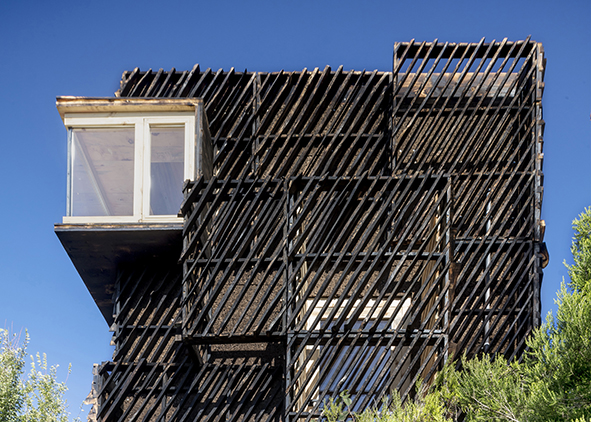Ecology and digital technologies. Small-scale architecture as a place of connections
DOI:
https://doi.org/10.19229/2464-9309/1032021Keywords:
ecology, circularity, digital, small-scale architecture, adaptabilityAbstract
Starting from the relationships between digital technologies and environmental culture, the essay aims to outline the contours of the new ecological dimension of architectural design as a place of multiple and interacting connections in which we can critically resolve the dichotomy between nature and culture. From this point of view, small-scale architecture provides a promising field of experimentation in which new technological systems, marked by more efficient ecological solutions, meet and integrate with the management of biological cycles. Industrial and production processes, rethought on the basis of the circularity paradigm, can be organised in a similar way to natural ecosystems with regard to the use of energy and materials, becoming a promising option for making them more efficient and sustainable.
Downloads
Article Metrics Graph
References
Batalle Garcia, A. Cebeci, I. Y. Vargas, C. R. and Gordon, M. (2021), “Material (data) Intelligence – Towards a Circular Building Environment”, in Globa, A., van Ameijde, J., Fingrut, A., Kim, N. and Tian Tian, S. L. (eds), Projections | Proceedings of the 26th International Conference of the Association for Computer-Aided Architectural Design Research in Asia (CAADRIA) 2021, vol. 1, Association for Computer-Aided Architectural Design Research in Asia, Hong Kong, pp. 361-370. [Online] Available at: caadria2021.org/wp-content/uploads/CAADRIA2021_Proceedings_Volume_1.pdf [Accessed 10 November 2021].
Bookchin, M. (2017), L’Ecologia della libertà [or. ed. The Ecology of Freedom, 1982], Elèuthera, Milano.
Bottazzi, R. (2018), Digital architecture beyond computers – Fragments of a cultural history of computational design, Bloomsbury Visual Arts, London.
Bryant, L. R. (2014), Onto-Cartography – An anthology of machines and media, Edinburgh University Press, Edinburgh (UK).
Carpo, M. (2017), The Second Digital Turn – Design beyond intelligence, The MIT Press, Cambridge (MA).
Coelho, M. and Grossman, T. (2017), “Crowd-driven pattern formation – Computational strategies for large-scale design and assembly”, in Tibbits, S. (2018), Autonomous assembly – Designing for a new era of collective construction, Wiley, Hoboken, New Jersey (US), pp. 50-59.
Dragone, R., Licciardi, G., Grasso, G., Del Gudio, C. and Chanussot, J. (2021), “Analysis of the Chemical and Physical Environmental Aspects that Promoted the Spread of SARS-CoV-2 in the Lombard Area”, in International Journal of Environmental Research and Public Health, vol. 18, issue 3, pp. 1-20. [Online] Available at: doi.org/10.3390/ijerph18031226 [Accessed 10 November 2021].
European Commission (2020), Communication from the Commission to the European Parliament, the Council, the European Economic and Social Committee and the Committee of the Regions – A new EU Circular Economy Action Plan for a cleaner and more competitive Europe, document 52020DC0098, 98 final. [Online] Available at: eur-lex.europa.eu/legal-content/EN/TXT/?qid=1583933814386&uri=COM:2020:98:FIN [Accessed 10 November 2021].
Floridi, L. (2017), La quarta rivoluzione – Come l’infosfera sta trasformando il mondo, Raffaello Cortina, Milano.
Hillebrandt, A., Riegler-Floors, P., Rosen, A. and Seggewies, J.-K. (2019), Manual of Recycling – Buildings as sources of materials, Detail, Munich.
Inghold, T. (2013), Making – Anthropology, Archaeology, Art and Architecture, Routledge, London.
Lewis, S. L. and Maslin, M. A. (2015), “Defining the Anthropocene”, in Nature, vol. 519, pp. 171-180. [Online] Available at: doi.org/10.1002/ad.2195 [Accessed 10 November 2021].
Marble, S. (ed.) (2013), Digital workflows in architecture – Design-Assembly-Industry, Birkhauser, Basel. [Online] Available at: doi.org/10.1515/9783034612173 [Accessed 10 November 2021].
Morin, E. (1993), Introduzione al pensiero complesso – Gli strumenti per affrontare la sfida della complessità, Sperling & Kupfer, Milano.
Nebuloni, A. and Rossi, A. (2018), Codice e progetto – Il computational design tra architettura, design, territorio, rappresentazione, strumenti, materiali e nuove tecnologie, Mimesis, Milano-Udine.
Picon, A. (2021), The Materiality of Architecture, University of Minnesota Press, Minneapolis (US).
Rau, T. and Oberhuber, S. (2016), Material matters – L’importanza della materia, Edizioni Ambiente, Milano.
Sposito, C. and Scalisi, F. (2020), “Ambiente costruito e sostenibilità – Materiali riciclati e Design for Disassembly tra ricerca e buone pratiche | Built environment and sustainability – Recycled materials and Design for Disassembly between research and good practices”, in Agathon | International Journal of Architecture, Art and Design, vol. 08, pp. 106-117. [Online] Available at: doi.org/10.19229/2464-9309/8102020 [Accessed 10 November 2021].
Tamke, M. (2017), “Foundamental changes for architecture”, in Commerel, A. H. and Feireiss, K. (eds), Craftmanship in the digital age – Architecture, value and digital fabrication, ANCB edition, Berlin, pp. 36-39. [Online] Available at: ancb.de/sixcms/detail.php?id=18846875 [Accessed 10 November 2021].
Zanotto, F. (2020), Circular architecture – A design ideology, LetteraVentidue Edizioni, Siracusa.

Downloads
Published
How to Cite
Issue
Section
License
This Journal is published under Creative Commons Attribution Licence 4.0 (CC-BY).
License scheme | Legal code
This License allows anyone to:
Share: copy and redistribute the material in any medium or format.
Adapt: remix, transform, and build upon the material for any purpose, even commercially.
Under the following terms
Attribution: Users must give appropriate credit, provide a link to the license, and indicate if changes were made; users may do so in any reasonable manner, but not in any way that suggests the licensor endorses them or their use.
No additional restrictions: Users may not apply legal terms or technological measures that legally restrict others from doing anything the license permits.
Notices
Users do not have to comply with the license for elements of the material in the public domain or where your use is permitted by an applicable exception or limitation.
No warranties are given. The license may not give users all of the permissions necessary for their intended use. For example, other rights such as publicity, privacy, or moral rights may limit how you use the material.


















































































